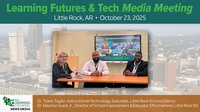Like most states, Hawaii has experienced significant challenges in recovering from the loss of instructional time during COVID-19. The results from state testing in 2022-23 indicated that 40 percent of Hawaii’s students overall were proficient in math, which is lower than the 43 percent achieved before the pandemic.
But even 43 percent proficiency is concerning. Clearly, there’s a huge need for accelerated learning to help students whose math skills are below grade level get back on track with their peers.
At Ka’umana Elementary School, a K-6 school in Hilo, Hawaii, we’ve been very effective in accelerating our students’ math achievement. The key to our success has been the use of diagnostic assessments that target students performing two or more years below their grade level. With these assessments, we can identify targeted strategies through math running records. These strategies are then implemented at the beginning, middle, and end of the school year, utilizing manipulatives and other visual tools to reinforce math facts and concepts
By recognizing which students need extra help right away and then delivering highly engaging interventions that have been proven to work, we’ve made considerable progress in closing math achievement gaps. In the 2023/2024 school year, for instance, 85 percent of first graders and 93 percent of second graders scored proficient in their end-of-year math assessments.
To implement a similar program at your school, a few changes to your approach at the beginning of the year can help minimize the effects of the summer slide and set your students up for a successful academic year.
Developing computational fluency
For students to perform increasingly complex calculations, they must become fluent with basic single digit math facts and computations. We’ve found that when elementary students can’t do grade-level math, it’s usually because they haven’t mastered their basic single digit math facts yet. Once they develop this math fact fluency, they can really soar with larger numbers, fractions, decimals and more.
Traditionally, teachers have used “drill and kill” methods to ensure that students learn these foundational skills. While The What Works Clearinghouse (WWC) does advocate for daily timed practice in computations, research shows that this approach alone can lead to math anxiety, particularly for struggling students. Instead of fostering understanding, it can create a counterproductive cycle where students doubt their abilities and dislike math.
To break this cycle, we take a more strategic approach by first providing students with time to identify and solve problems using specific strategies. This helps them apply what they learn more effectively, leading to a deeper understanding and greater confidence in their mathematical abilities.
For example, students can use the “bridge to 10” strategy when adding numbers like 7 + 9. They can break it down as 6 + (1 + 9), which leads to 16. This approach helps students connect smaller numbers to 10, making the addition process more intuitive. Alternatively, when using the 'count on' strategy, students should start with the bigger number to avoid counting all the numbers from the beginning. For instance, with 2 + 7, they would start with 7 and count on 2 more to get 9, instead of counting up from 1.
Giving them strategies right out of the gate that they can apply when they can’t recall a math fact helps reduce anxiety and leads to better results. But some students need more exposure before they can apply these strategies for themselves. Our Tier 2 math intervention time gives students an opportunity to practice these strategies using games and manipulatives that include a visual component.
We assess all students early in the school year, and students who are identified as achieving below grade level are given further assessment using Math Running Records to see how well they can apply each of these computational strategies. In essence, we’re using a broad filter to identify the students who need more help, and then we’re diving deeper into the specific needs of these students.
Based on the information from these assessments, we gain the awareness needed to implement targeted strategies to address each student's learning needs. We then put students into small groups and provide further practice using visual models. To keep students engaged, we incorporate repeated practice through games, which gamify the learning process and make it enjoyable. We use resources like the Math Book and Box of Facts from ORIGO Education, which includes laminated cards and other tools that help students visualize basic math facts and strategies while practicing fluency in a fun and interactive way.
We assess students again in the middle of the school year and toward the end of the year to see where they are and to exit them out of interventions or regroup them if necessary. We try to limit each group to no more than six students, as we’ve found the smaller the group size, the better.
Results speak for themselves
Visuals and manipulatives really make a difference. They help students understand the computational strategies and connect the concrete representation to the abstract rule or math fact. To support this understanding, we use the Fundamentals books, which offer an abundance of classroom math games and strategies, enhancing students' ability to calculate mentally while improving their problem-solving skills, encouraging meaningful discourse, and promoting the use of appropriate mathematical language
In a research project with the University of Hawaii College of Education, 60 percent of our students in grades 2-3 and 78 percent of students in grades 4–6 increased their math skills by at least one grade level during a four-month intervention period.
As students’ efficacy increases, so does their confidence and their enjoyment of math. We had one fifth-grade ESL student who didn’t want to do math at all. His face would just drop when I told him we were going to practice math together. But the visuals and manipulatives helped him a lot—and he advanced by at least two grade levels in math last year. He now knows all his multiplication facts instantly. Because he has this necessary foundation, he is more confident and more capable in math.
Teaching math fact fluency through drill and kill is causing anxiety among students. But there are better ways.
By identifying students who are struggling early in the school year, giving them highly targeted practice based on conceptual understanding and strategies they can use when they can’t recall their math facts, and using manipulatives and other visual tools to drive home these strategies, teachers can accelerate math learning and bring kids up to grade level proficiency quickly. We teach these strategies in a specific order: we start by helping students achieve accurate answers with a reliable strategy that they can draw, model, and check. Then, we move on to flexibility, encouraging them to apply more than one strategy. As they progress, students work on efficiency by selecting the most effective strategy for their problem, and finally, we aim for automaticity in their recall and application of math facts. We’ve seen how well this works for us, and we have the results to prove it.
About the author
Akemi Faria is the Academic Coach at Kā’umana Elementary School in Hawaii. She has 17 years of experience as a classroom teacher in grades K-5.











